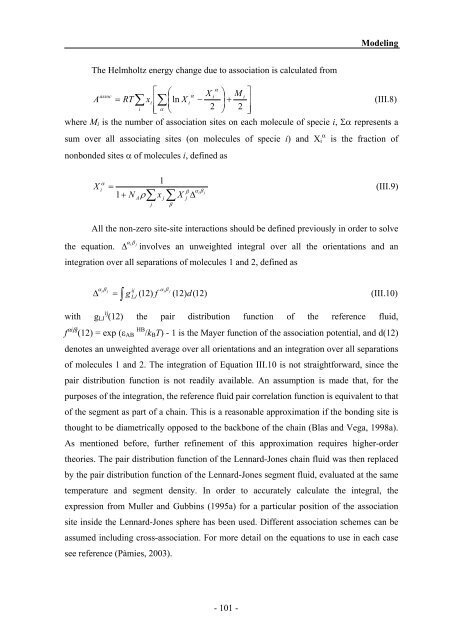n - PATh :.: Process and Product Applied Thermodynamics research ...
n - PATh :.: Process and Product Applied Thermodynamics research ...
n - PATh :.: Process and Product Applied Thermodynamics research ...
You also want an ePaper? Increase the reach of your titles
YUMPU automatically turns print PDFs into web optimized ePapers that Google loves.
The Helmholtz energy change due to association is calculated from<br />
Modeling<br />
α<br />
⎡ ⎛<br />
⎞ ⎤<br />
assoc<br />
α X<br />
∑ ⎢∑⎜<br />
i M<br />
⎟ i<br />
A = RT xi<br />
⎜<br />
ln X i −<br />
⎟<br />
+ ⎥<br />
(III.8)<br />
i ⎢⎣<br />
α ⎝ 2 ⎠ 2 ⎥⎦<br />
where Mi is the number of association sites on each molecule of specie i, Σα represents a<br />
sum over all associating sites (on molecules of specie i) <strong>and</strong> Xi α is the fraction of<br />
nonbonded sites α of molecules i, defined as<br />
X<br />
α<br />
i<br />
=<br />
1+<br />
N ρ<br />
A<br />
β<br />
∑xj∑XjΔ j<br />
1<br />
β<br />
α β<br />
i<br />
j<br />
(III.9)<br />
All the non-zero site-site interactions should be defined previously in order to solve<br />
αiβ<br />
j<br />
the equation. Δ involves an unweighted integral over all the orientations <strong>and</strong> an<br />
integration over all separations of molecules 1 <strong>and</strong> 2, defined as<br />
α β<br />
∫<br />
i j ij<br />
i j<br />
Δ = g ( 12)<br />
f ( 12)<br />
d(<br />
12)<br />
(III.10)<br />
LJ<br />
α β<br />
with gLJ ij (12) the pair distribution function of the reference fluid,<br />
f αiβj (12) = exp (εAB HB /kBT) - 1 is the Mayer function of the association potential, <strong>and</strong> d(12)<br />
denotes an unweighted average over all orientations <strong>and</strong> an integration over all separations<br />
of molecules 1 <strong>and</strong> 2. The integration of Equation III.10 is not straightforward, since the<br />
pair distribution function is not readily available. An assumption is made that, for the<br />
purposes of the integration, the reference fluid pair correlation function is equivalent to that<br />
of the segment as part of a chain. This is a reasonable approximation if the bonding site is<br />
thought to be diametrically opposed to the backbone of the chain (Blas <strong>and</strong> Vega, 1998a).<br />
As mentioned before, further refinement of this approximation requires higher-order<br />
theories. The pair distribution function of the Lennard-Jones chain fluid was then replaced<br />
by the pair distribution function of the Lennard-Jones segment fluid, evaluated at the same<br />
temperature <strong>and</strong> segment density. In order to accurately calculate the integral, the<br />
expression from Muller <strong>and</strong> Gubbins (1995a) for a particular position of the association<br />
site inside the Lennard-Jones sphere has been used. Different association schemes can be<br />
assumed including cross-association. For more detail on the equations to use in each case<br />
see reference (Pàmies, 2003).<br />
- 101 -



